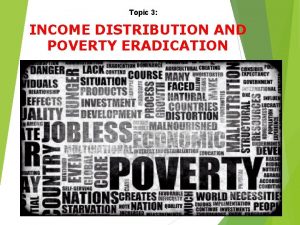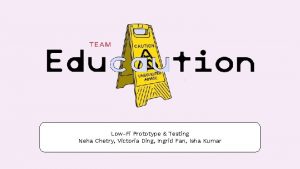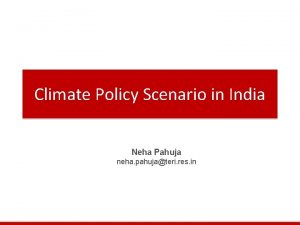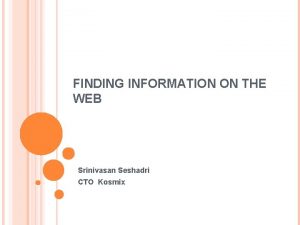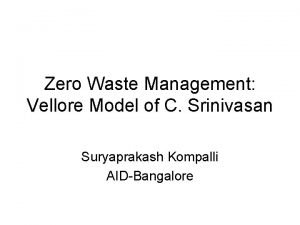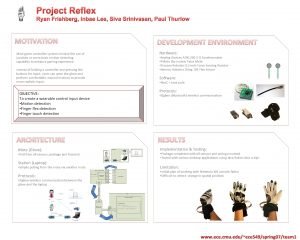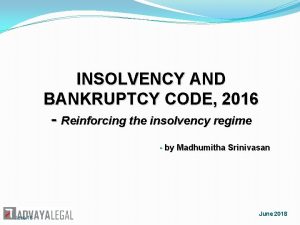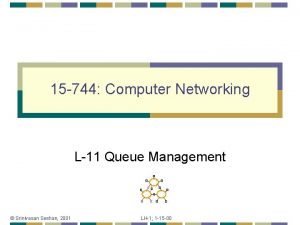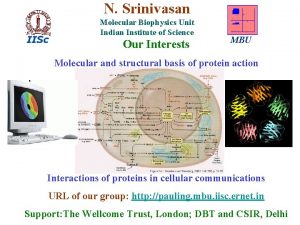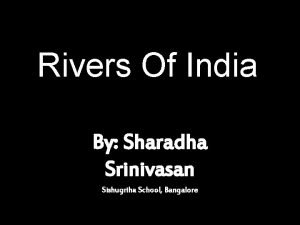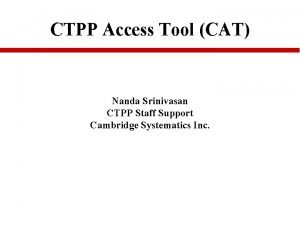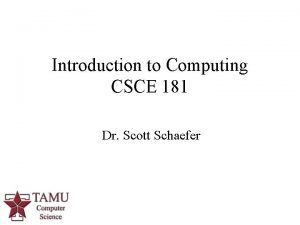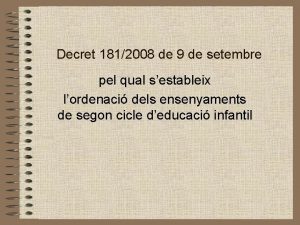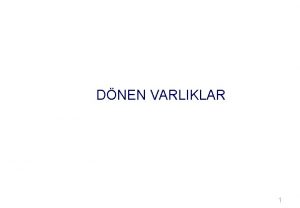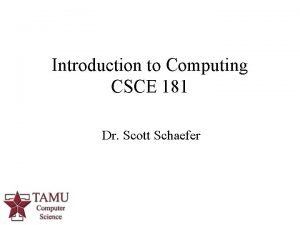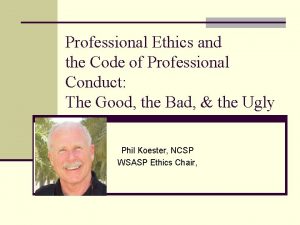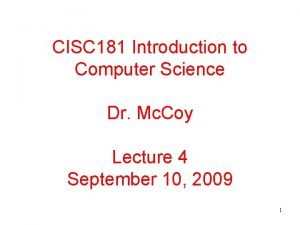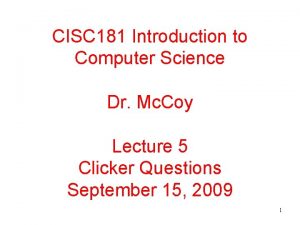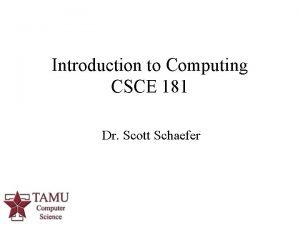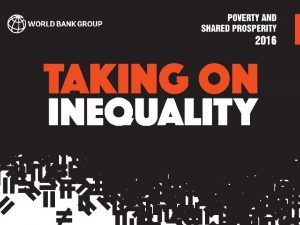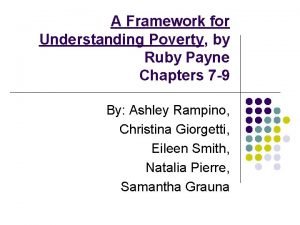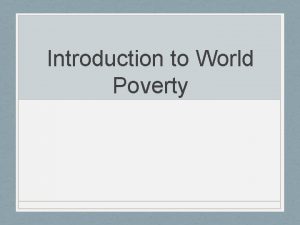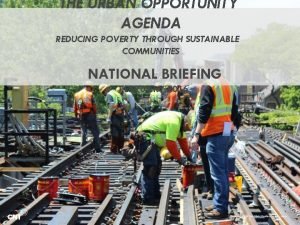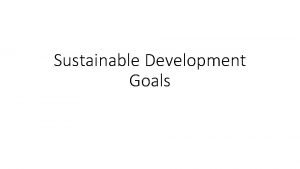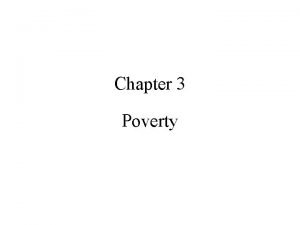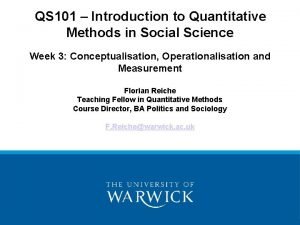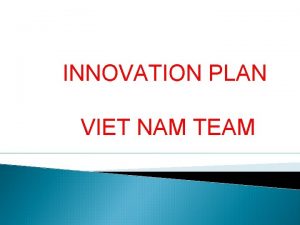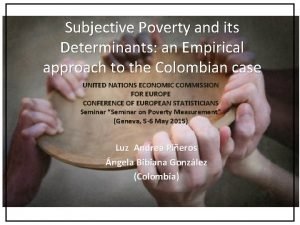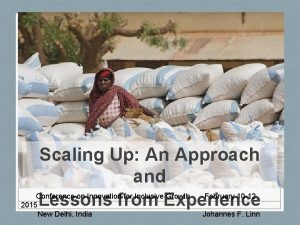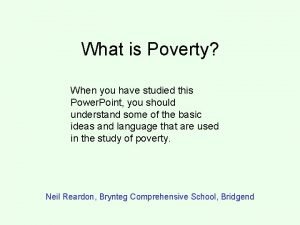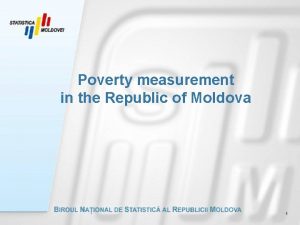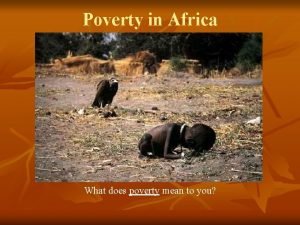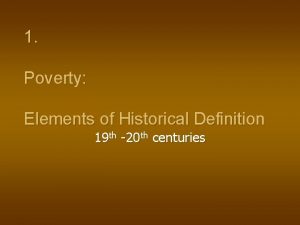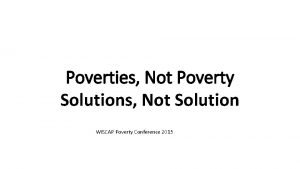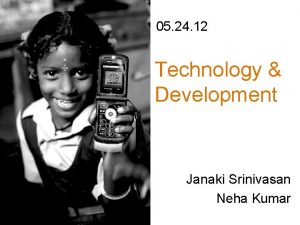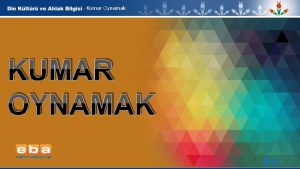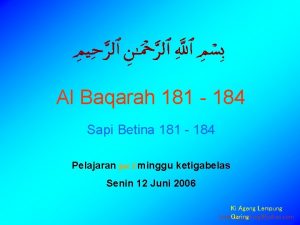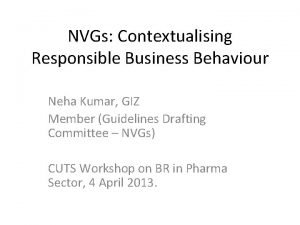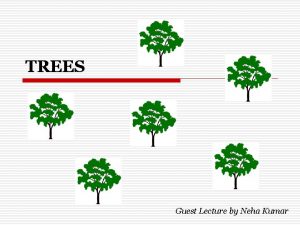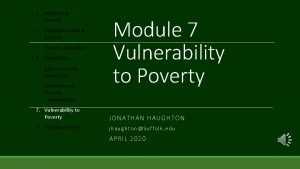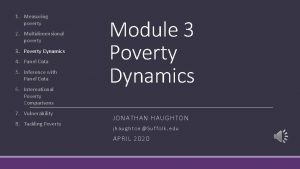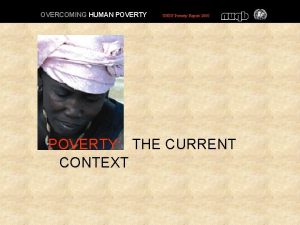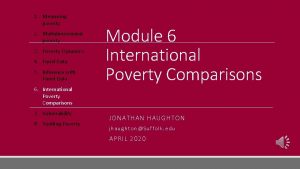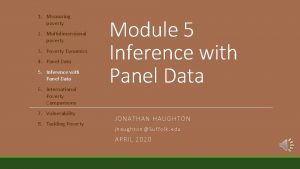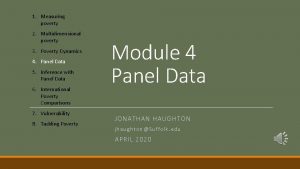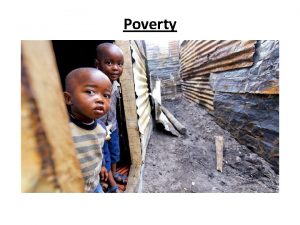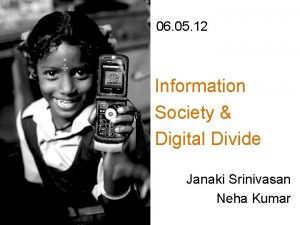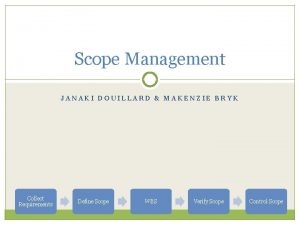I 181 Technology Poverty Janaki Srinivasan Neha Kumar







































![OLPC What/Who is being developed Kids (elementary school age) [not schools, teachers] Proximate change OLPC What/Who is being developed Kids (elementary school age) [not schools, teachers] Proximate change](https://slidetodoc.com/presentation_image_h2/8efacd7ad18c0c8520742700fdadafca/image-40.jpg)
















- Slides: 56

I 181 Technology & Poverty Janaki Srinivasan Neha Kumar

Outline for Today • Grades • Review of key questions from Class 1 • Our attempts to answer these • Your attempts to answer these

Grades! • Class Participation: 5 • Activities: 10 – Technology and Poverty photograph: 2 • 2 if submitted, 0 if not – Green Revolution: 4 • Your scores have been doubled! – Sproul Plaza: 2 • 2 if submitted, 0 if not – Community Radio: 2 • Reading Responses: 15 overall, 5 each – √- = 2 – √ =4 – √+ = 5 • Assignment 1: 30 • Assignment 2: 40 To pass: 60

The Key Questions • What’s the history of the idea that technology can help alleviate poverty, bring about development? • What models of development, definitions of technology, and metrics of poverty did such ideas give rise to? • How do “the poor” describe their lives and use these technologies?

Back to the beginning

The Key Questions • What’s the history of the idea that technology can help alleviate poverty, bring about development? • What models of development, definitions of technology, and metrics of poverty did such ideas give rise to? • How do “the poor” describe their lives and use these technologies?

History of an Idea ? ? 1949 2005

Technology and Development in 1949 Truman's Inaugural Address (January 20, 1949) “The material resources which we can afford to use for assistance of other peoples are limited. But our imponderable resources in technical knowledge are constantly growing and are inexhaustible. I believe that we should make available to peace-loving peoples the benefits of our store of technical knowledge in order to help them realize their aspirations for a better life. And, in cooperation with other nations, we should foster capital investment in areas needing development. ” “Greater production is the key to prosperity and peace. And the key to greater production is a wider and more vigorous application of modern scientific and technical knowledge. ” Text available: http: //www. trumanlibrary. org/whistlestop/50 yr_archive/inagural 20 jan 1949. htm

Technology and Development in 2005 Friedman tells us: Technology has made the World “Flat”

Questions for Truman and Friedman (and for us!) Does technology determine social, economic, political change?

How does technology operate in a world that is NOT flat? Source: Richard Florida’s “The World is Spiky, ” Atlantic Monthly, October 2005.

The Key Questions • What’s the history of the idea that technology can help alleviate poverty, bring about development? • What models of development, definitions of technology, and metrics of poverty did such ideas give rise to? • How do “the poor” describe their lives and use these technologies?

Technology: Review • As artifact and as ideology (‘hazardous’ concept? ) • The material form of a technology as shaped by social processes (see SCOT) – Relevant Social Groups – Interpretive Flexibility – Closure – Black-boxing • Guard against Technological Determinism!

Development: Review • Paradigms of Development – Neoclassical Economics & Modernization Theory – Marxist Economics & Dependency Theory • Models and Metrics of Development from the Dominant Paradigm • Changes in Metrics and Models over six decades • Aid regime (1950 s-1960 s) • Basic needs (1970 s) • Structural adjustment/ Washington consensus (1980 s 1990 s) • New Institutionalism (post 1990 s)

Development: Two paradigms* • Neoclassical Economics & Modernization Theory – Linear path to modern model of the West (capitalist industrialization + liberal democracy) – Technology’s Role: Push to change from simple and traditional techniques to the application of scientific knowledge. • Marxist Economics & Dependency Theory – Growth of developed world only possible at the expense of developing regions. Aid is exploitative and paternalistic. Inequalities intensify. The imperialist project continued. – Technology's Role: Expanding the market for Western innovations – industrial equipment, fertilizers and pesticides, etc. *Read Thomas (2000) for more on differences between the two Rostow (1960) and Easterly (2002) for rise and decline of development economics and Modernization theory

Dominant Models of Development AID REGIME 1950 1960 BASIC NEEDS 1970 STR. ADJ. + WASHINGTON CONSENSUS 1980 1990 NEW INSTITUTIONALISM 2000

Changing Models of Development • Aid regime (1950 s-60 s) based on neoclassical theory of economic growth = aid for investment, capital for industrialization • Basic needs (1970 s) = investments to raise the productivity of the poor • Structural Adjustment and the Washington Consensus (1980 s and 1990 s) = aid tied to policy changes, liberalization, reduction of government, opening up to global trade • New institutionalism (post 1990 s) = the government matters after all – social welfare role, to ensure functioning markets and to provide health/education thus keeping the labor force productive

Changing Metrics too? • From GDP-centric definitions • To – Capabilities Approach = change in per capita GDP is not development; development is the generation of political, economic, social freedoms (Sen’s capabilities approach in today’s reading) – Sustainable Development (late 1980 s) = growth but with more careful resource management and environmental preservation to ensure long-term continuation (Bruntland report) – UN’s Millennium Development Goals (MDGs) = aid is tied to targeting and accomplishing the multi-dimensional MDGs

Model of Development as Framework for Analysis • A model of development • entity doing development • object of development • goals of development • preferred means of development • Role of technology?

Thinking Big in Industrialization Akosombo Dam Who is doing the development World Bank, national government, Kaiser? What/Who is being developed The national economy Proximate change Electricity supply for factories, to sell to neighbors, (short-term) to be self-sufficiency in power generation brought about The eventual outcome or development to accomplish Industrialization of economy leading to growth and higher standard of living Building a hydroelectric dam with financial support Mechanism for bringing about this from a consortium of international investors (USAID, Kaiser, etc. ) change

Thinking Big in Agriculture Green Revolution Who is doing the development What/Who is being developed Proximate change (short-term) to be brought about The eventual outcome or development to accomplish Mechanism for bringing about this change

Re-Thinking BIG • Rethinking – scale – distribution of costs and benefits (and who decides) – ecological considerations • Alternatives? – Appropriate technologies – Sustainable development – Participatory development • Social entrepreneurship?

Appropriate Technology “What can be done to bring health to economic life outside the big cities, in the small towns and villages which still contain – in most cases – 80 to 90 per cent of the total population? ”

Sustainable Development • Short-term productivity gains come with rapid depletion of resources that puts future production in jeopardy. • Boosting yields isn’t enough. We must also consider how to manage natural resources to ensure future productivity. • Brundtland Report (1987) stresses the need for sustainable development.

Participatory Development Chambers (1990 s) • Data Collection for Needs Assessment – Emphasis on consultation • “the basic human right of poor people to conduct their own analysis. ” – Data should be shared • rather than extracted

“Whose Reality Counts? ” • How are variations accounted for? – “the realities of poor people are local, complex, diverse and dynamic” • How are priorities set? – “one may speculate on what topics the poor and powerless would commission papers if they could convene conferences and summits” – “what matters most to [the poor] often differs from what outsiders assume, is not always easy to measure, and may not be

Just another Bottom-Up Approach? Participatory Development Social Entrepreneurship Means Ends Carried out by the Group Championed by a tireless individual Entrepreneur ‘Socio-cultural animator’ The targeted community are key collaborators Does not explicitly identify what relationship with targeted community ought to be

Enter Information Age and Digital Technologies

Eras defined by (technological) innovations In re form vo lu atio n n? The First Industrial The Post-Industrial Revolution (18 th Society century) – spinning Jenny, steam engine, The Information The Second Industrial transport Economy Revolution (from around 1850) – steel The Network Society and electricity The Atomic Age? Adam Smith Karl Marx Daniel Bell Alvin Toffler M. U. Porat Fritz Machlup Manuel Castells

Information Societies • What is information to Info Society theorists? • Influence of Information Theory (a field of applied mathematics) – “the fundamental problem of communication is that of reproducing at one point, either exactly or approximately, a message selected at another point. ” – Claude Shannon, Bell Labs 1948

Information Societies: Criticism – Ignores issues of information quality – More of something (quantitative increase) doesn’t necessarily yield a changing social order (qualitative change – Info-determinism in play? – Centrality of information in society is not new • all societies place central importance on information (Castells, Giddens, Darnton!)

The Digital Divide

Not One But Many 1. Rich, educated, powerful vs. not 2. Linguistic and cultural 3. Rich nations vs. poor 4. Emergence of the digerati

Bridging the Divide • What is the end-goal? – Improvements in socio-economic conditions – Improvements in the realms of governance, education, health… • What are the means? – Providing access to ICTs • What is meant by ‘access’? • What is included in ‘ICTs’?

Dimensions of Accessing ICTs �Hard infrastructure (fiber optic, copper, wireless, etc) �‘Soft’ infrastructure (government policy) �Business models (to lower cost, ensure ongoing feasibility) �Connecting Devices (Multi. Mouse, OLPC, desktop PC) and access models (individual or shared access) �Socio-cultural dimensions (specifically as they relate to gender and class)

A Divide between ‘Haves’ and ‘Have-nots’…? �Those who have used a technology (at least once) vs. those who never have �Those who can get to and pay for technology (though some may choose not to use it) �Frequency of use and whether this is equitable between groups �Quality of use and actual benefits (perhaps frequency doesn’t reflect this? ) Or a Spectrum of Access and Use?

‘ICT’: Single Technology? • Form factor (physical dimensions (size) and hardware configuration) • Input/output mechanisms (i. e. voice vs. text, keyboard vs. keypad vs. touchscreen) • Repurposed vs. Custom device (desktop computer vs. One Laptop Per Child device) Or a Range of Connecting

Making Connecting Devices Accessible • Low-cost devices • OLPC • Shared Access devices • Multimouse • Public Access or Pay Per Use • Kiosks

Towards Development?
![OLPC WhatWho is being developed Kids elementary school age not schools teachers Proximate change OLPC What/Who is being developed Kids (elementary school age) [not schools, teachers] Proximate change](https://slidetodoc.com/presentation_image_h2/8efacd7ad18c0c8520742700fdadafca/image-40.jpg)
OLPC What/Who is being developed Kids (elementary school age) [not schools, teachers] Proximate change (short-term) to be brought about Smarter, more creative, problem-solving children The more distant outcome/development to accomplish Possibly a better moreeducated labor force? A new generation that can solve the countries’ problems in unique ways? Mechanism for bringing about this change Distribution of a special kind of inexpensive, durable laptop with software that will bring about this evolution/education of children

Quest to Learn Q to L What/Who is being developed Middle graders in NYC Proximate change (short-term) to be brought about Learn Better The more distant outcome/development to accomplish Smarter, more creative, problem-solving children for a digital age Mechanism for bringing about this change Gaming-centric School Curriculum

Public Access Village Kiosks What/Who is being developed Village Residents Proximate change (short-term) to be brought about Ready access to Information The more distant outcome/development to accomplish Better functioning market, government (with e-governance services) Mechanism for bringing about this change Information Provision using ICTs in kiosks

Community Radio Our Voices What/Who is being developed Proximate change (short-term) to be brought about The more distant outcome/development to accomplish Mechanism for bringing about this change

Citizen Media CGNet Swara What/Who is being developed Proximate change (short-term) to be brought about The more distant outcome/development to accomplish Mechanism for bringing about this change

Citizen Media Acopio, Mobileworks… What/Who is being developed Proximate change (short-term) to be brought about The more distant outcome/development to accomplish Mechanism for bringing about this change

The Key Questions • What’s the history of the idea that technology can help alleviate poverty, bring about development? • What models of development, definitions of technology, and metrics of poverty did such ideas give rise to? • How do “the poor” describe their lives and use these technologies?

Appropriation of Technology

Mobile Use in China

Mobile Use in India

Your attempt at these questions? • What’s the history of the idea that technology can help alleviate poverty, bring about development? – Possibly in Assignment 1 • What models of development, definitions of technology, and metrics of poverty did such ideas give rise to? – Green Revolution debate, Assignment 1 • How do “the poor” describe their lives and use these technologies? – Assignment 1 and 2

Our Objectives?

Technology beyond Instrumentalism Technology • as shaped by the social, political, and economic • as a powerful ideological concept (as ‘hazardous’) • as meaning something more to poor populations than a ‘solution’ to their ‘poverty’

Poverty beyond Metrics Poverty • as having no universal, uncontested definition or metrics • as relational, rather than about an absolute lack of assets • not just as described by institutional perspectives and metrics • BUT also as described by the diverse people who experience it

Worth Adding to the List? Access beyond Developmentalism Needs beyond the Material

Did we succeed?

Thank you!
 Relative poverty
Relative poverty Neha urkude
Neha urkude Bio medical waste management introduction
Bio medical waste management introduction Victoria ding
Victoria ding Jamie fu
Jamie fu Neha premkumar
Neha premkumar Neha pahuja
Neha pahuja Sathish srinivasan
Sathish srinivasan Srinivasan seshadri
Srinivasan seshadri C srinivasan waste management
C srinivasan waste management Ryan hendrixson
Ryan hendrixson Avaya wos
Avaya wos Madhumitha srinivasan
Madhumitha srinivasan Dr k srinivasan
Dr k srinivasan Queuing discipline in computer networks
Queuing discipline in computer networks Molecular biophysics unit
Molecular biophysics unit Sharadha srinivasan
Sharadha srinivasan Nanda chart
Nanda chart 181
181 Ms 181 weebly
Ms 181 weebly Hymn 100
Hymn 100 Dönem ayırıcı hesaplar
Dönem ayırıcı hesaplar 181
181 Csce 181
Csce 181 Thy 181
Thy 181 Decret 181/2008, de 9 de setembre
Decret 181/2008, de 9 de setembre Dönem ayirici hesaplar 180 181 280 281 380 381
Dönem ayirici hesaplar 180 181 280 281 380 381 Csce 181
Csce 181 Wac 181-87
Wac 181-87 Majesteit groot is zijn majesteit
Majesteit groot is zijn majesteit Cisc 181
Cisc 181 Cisc 181
Cisc 181 Csce courses tamu
Csce courses tamu Inequality and poverty
Inequality and poverty Ruby payne framework for understanding poverty
Ruby payne framework for understanding poverty Poverty definitions
Poverty definitions Songs about poverty
Songs about poverty Principal of uno
Principal of uno Ways to reduce poverty
Ways to reduce poverty No poverty
No poverty Headcount index example
Headcount index example The causes of poverty
The causes of poverty Poverty and juvenile delinquency
Poverty and juvenile delinquency Poverty brainstorming
Poverty brainstorming Swot analysis of poverty
Swot analysis of poverty Mental model of poverty
Mental model of poverty Low income poverty
Low income poverty Poverty conclusion
Poverty conclusion Poverty in peru
Poverty in peru Poverty of the stimulus
Poverty of the stimulus Types of poverty
Types of poverty My experience with poverty
My experience with poverty St john chrysostom on wealth and poverty pdf
St john chrysostom on wealth and poverty pdf Moldova poverty
Moldova poverty Result of poverty
Result of poverty Poverty index formula
Poverty index formula Poverties
Poverties
